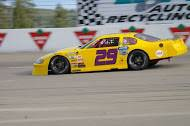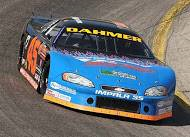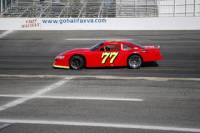Who is right – the driver or the crew chief? Since I spent my racing career as a crew chief I would like to say crew chief yet I know corner chemistry comes for understanding when to allow the driver to prevail as well as knowing when to let the crew chief earn his reputation. Teams would be much better off to focus on communication and leave the ego and need to be right for congress.
Our goal is to have fast race car that can win every time it hits the track. Racers are competitive and the desire to win can create tension. Time is short during practice and the intensity relies on good chemistry to avoid communication strain.
“- I was so bent on past success that I didn’t adapt to his feedback. I “knew” I was right and the car would be fast.”
While this article relates to the driver and crew chief as separate people, many of the concepts and thought processes apply if you are a driver that fills the crew chief role on your own. Curt Spalding of AllStar Performance is a successful dirt driver that is regarded as an excellent chassis guy. Curt points out that many short track racers act as their own crew chief. For those of you in this category, it pays to break down the corner as if you were explaining handling issues to another person. When considering adjustments it is beneficial to get out of driver mode and think through the corner section by section.
The best driver/crew chief combos have learned to communicate in a respectful fashion and have practiced how to transfer information to accelerate the decision process. The word “team” applies and the set up for the week begins in the shop. Communication in the shop has the luxury of time so it pays to think about alternate adjustments while in the relaxed atmosphere of the garage and prepare some options if the baseline set up comes up short.
Crew chiefs can help their drivers by “accepting” driver feedback. One time I was helping a new driver and I think I could have listened better. The track was old, flat, and bumpy – just plain wore out. Portland Speedway doubled as a drive in Movie Theater and it was always funny to see the movie speaker stands in the infield. Anyway, at one time Portland was a track where I really struggled as a crew chief and through hard work and plenty of trial and error I found some corner magic. My “found” set up was proven with two different drivers and I think my teams won about 7 races in a short span during our tour stops. We were the car to beat – good times. Our set up was certainly different and it was fun to have the outside the box ideas win consistently.
When I went to Portland with a new driver I had my proven set up and the confidence that we would go there and with a great chance to win. We got there and the driver whined about the car the through the entire practice and I was so bent on past success that I didn’t adapt to his feedback. I “knew” I was right and the car would be fast. I think we finished 25th 2 laps down. I learned a lot that day – so much for being right. The driver has to be comfortable in the car and the past doesn’t turn the steering wheel. I should have cultivated his feedback and “fixed” the car so it was drivable for him and his individual talent. He was a winning driver and the car was a winning car. Communication issues took a winning effort and made it 25th. Given another chance, I would have mounted the wheels on the roof to make the driver happy. From that day forward my goal was to hear the driver and make him comfortable in the car.
So how do you build driver and crew chief chemistry? Respectfully listening would be a good place to start. From there it pays to be business like in your approach to driver feedback at the end of each practice session. A routine that is followed creates a business like approach will reduce emotion allowing for the information transfer to be complete. Helping the driver to be relaxed will help him to provide digestible information. Aiming for digestible information transfer is something to think about – it is hard to fix a car if the driver says it is loose in, pushes in the middle and then snaps loose off. Break down the corner and go in sequential segment order after every practice session. Tire temps are worthless when the driver has every bad corner condition going on at the same time.
If a car is loose on entry then nothing else in the corner makes any difference. How can the car be good in the middle if the driver is afraid to turn the steering wheel? If the entry is bad the middle will be a challenge too and the loose in condition just about always causes a push in the middle. Focus on the entry first and manage each section of the corner in order. I like to break the corner into 6 categories and work on making the car feel good at point 1 first. I then go to point 2 and so on. If I get to point 3 and make an adjustment that makes point 1 unacceptable then I must start over. The corner sequence has to be followed. If point 1 is off the rest of the turn will be less than perfect.
My first 5 corner points are the Braking, Turn In, Middle (Apex), Acceleration and Exit. Below are my definitions for these areas but your team can use their own terminology if it helps to get everyone one the same page? My 6th corner section is overall comfort and drivability. A focus on a drivable car saves equipment and makes drivers very happy.
Point 2 – Turn In
The Turn in is the point in the corner where the driver turns the wheel and pulls the car towards the bottom. Maximum brake pressure is transitioning to minimum brake pressure and by the end of the area brake pressure is at zero. Keep in mind that at every track these areas change and the end of the turn in area is where zero braking is found regardless of the actual geographical place in the corner.
Point 3 – Middle (Apex)
The middle is the point in the corner where the steering wheel is turned to the maximum amount. The car will roll through the center point. Brake pressure is at zero and the driver picks up the throttle to some degree which will vary from track to track.
Jason Knaus
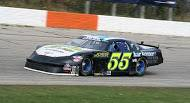 Jason Knaus nails fast time at Lacrosse Oktoberfest. Notice how the LF tire is lower than the LR tire in comparison to the white line – driver’s should aim for feeling the LF lower than the LR. Jason’s car is really cutting through the middle just about guaranteeing a hooked up exit. The middle is the point in the corner where the steering wheel is turned to the maximum amount. The car will roll through the center point. Brake pressure is at zero and the driver picks up the throttle to some degree which will vary from track to track.
Jason Knaus nails fast time at Lacrosse Oktoberfest. Notice how the LF tire is lower than the LR tire in comparison to the white line – driver’s should aim for feeling the LF lower than the LR. Jason’s car is really cutting through the middle just about guaranteeing a hooked up exit. The middle is the point in the corner where the steering wheel is turned to the maximum amount. The car will roll through the center point. Brake pressure is at zero and the driver picks up the throttle to some degree which will vary from track to track.
Point 4 – Acceleration
The Acceleration area is the part of the corner after the point where the car has taken a “set” and is pointed for maximum exit speed. The driver gets on the throttle in can see the exit.
Michael Hastings
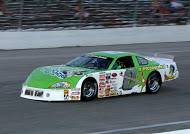 Michael Hastings is shown getting on the throttle. The car is pointed after rolling through the middle creating a fast exit. The Acceleration area is the part of the corner after the point where the car has taken a “set” and is pointed for maximum exit speed. The driver gets on the throttle in can see the exit.
Michael Hastings is shown getting on the throttle. The car is pointed after rolling through the middle creating a fast exit. The Acceleration area is the part of the corner after the point where the car has taken a “set” and is pointed for maximum exit speed. The driver gets on the throttle in can see the exit.
Point 5 – Exit
The exit area is where the car transitions from partial to maximum throttle. Some tracks have a second apex where the car can become loose under full throttle. The car is still turning and the straight is clearly in view.
Jay Smith
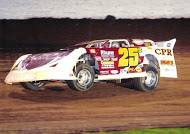 Jay Smith is killing the exit and his car is launching down the straight. Stock Car guys would enjoy this much grip! The exit area is where the car transitions from partial to maximum throttle. Some tracks have a second apex where the car can become loose under full throttle. The car is still turning and the straight is clearly in view.
Jay Smith is killing the exit and his car is launching down the straight. Stock Car guys would enjoy this much grip! The exit area is where the car transitions from partial to maximum throttle. Some tracks have a second apex where the car can become loose under full throttle. The car is still turning and the straight is clearly in view.
Point 6 - Driver Comfort
Driver comfort is a paramount goal. Many times you can have a car with knife edge speed. These cars are hard to drive and often the added speed disappears when the tires get hot or in traffic. Often I have dialed out knife edge speed in favor of a car that is more drivable. Sometimes the knife edge can be used for qualifying but for late models a set up that allows the driver to drive aggressively will result in more speed over the long haul. If you have to compromise and an earlier corner segment is off a bit it is ok to tackle the corner condition that makes the car uncomfortable for the driver.
Example
Here is an example of walking the driver through the corner breakdown process – if you act as your own crew chief the breakdown is basically the same:
ENTRY
Crew Chief: Can you drive into the corner and feel the car is stable?
Driver: The car gets in good.
Crew Chief: How about when you hit the brakes hard? Still ok – no loose in feeling?
Driver: Yes – it’s getting in good even if I over drive it in.
NOTE: I train my drivers to make sure the car gets in the turn so they can drive aggressively. My teams know loose in is just not allowed and we will go to any length to make sure the car gets in deep and with a stable attitude every time. I am happy to make the driver nuts asking repeated questions about corner entry as we must be sure any possibility of loose in is eliminated. Yes – this is worth repeating several times!
Crew Chief: Ok – we are getting in good. How about the Turn In to the corner. Can you turn the wheel with out fear and pull the car to the bottom aggressively? Does the car take a set and cut well?
Driver: Yes – I can turn it hard on the Turn In – all good.
NOTE: I teach drivers to feel like the LF is always slightly closer to the white line than the left rear in the middle. If drivers turn the wheel and get the car on the white line with the LF lower on the track then the LR you know the car is cutting well and the angle to the exit will allow the driver to hammer the throttle.
Crew Chief: Ok how does the car turn in the middle?
Driver: The car picks up a push in the middle. It just doesn’t cut. When I pick up the throttle it gets tighter and then when I get to the exit it snaps loose.
Crew Chief: Ok, let’s work on the middle. How do you feel about a quarter inch of additional stagger and raising the J-bar an inch?
Driver: It’s already snapping loose off – won’t that make it worse?
Crew Chief: let’s get it rolling through the middle. If we get it to cut through the center it will be pointed down straight. The wheel won’t be turned as much so it will hook up when we approach the exit at the right angle. Let’s focus on the middle first and see if the exit gets better when the car turns through the middle better.
NOTE: A car that is just a little tight after rolling though the center is easy to drive and fast. A car with a push in the middle is no fun. A little snug can help with a solid and stable exit. A car that pushes will make for a loose exit that gets looser lap after lap.
There are a million scenarios and your team can work the corner conversation focusing on each segment in sequence. Move back to the start if an adjustment upsets a prior segment.
Teams should also keep in mind the big picture when it comes to chassis adjustments. Sometimes you have gone too far and the so called adjustment rules no longer apply. During these times you end up doing the opposite of what the book says. If the car has a push it is common to use less RF spring. But what if you have gone down to a 5 pound spring in the front and the push is still there? In some cases more RF spring would help the car turn better. If you have gone to an extreme or then the opposite approach should be considered. Your choice to use a softer RF spring to cure a push is based on going softer than a predetermined baseline. Maybe the baseline was off? Be aware of those times when adjustments are not making sense. Perhaps you have gone through the adjustment center and you may need to go the other way with your thinking.
If your team spends the time to find common terminology while taking a systematic approach in communication cornier chemistry will automatically improve. Breaking down the corner into segments will make it much easier for the drivers to communicate what they are feeling.
Be completely aware at all times that the car must get through each section in order. A car that is loose in will just about always push in the middle. A car that pushes in the middle is often loose off. Drivers can explain a push then be worried about the car being loose sending their chassis adjustments off in the wrong direction. The cure is to break the corner down and only move on to the next section when the preceding section is spot on. If a change sets back a prior corner section then start the process from the beginning. Corner chemistry will be built due to your systematic approach resulting in more chances to spray Champagne.

